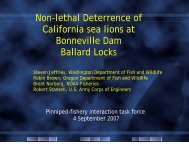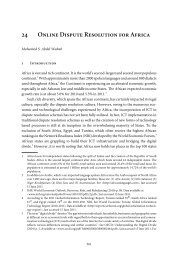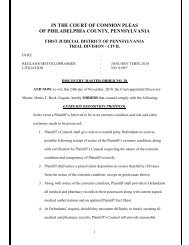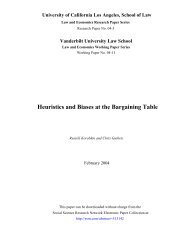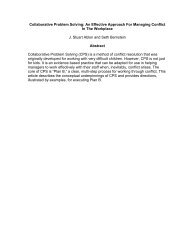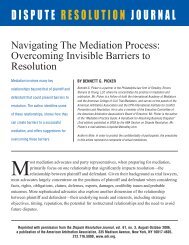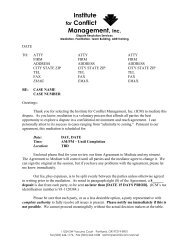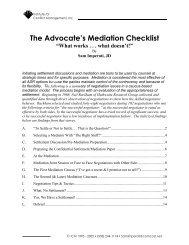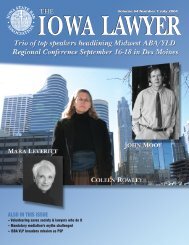19 ODR in North America - Mediate.com
19 ODR in North America - Mediate.com
19 ODR in North America - Mediate.com
Create successful ePaper yourself
Turn your PDF publications into a flip-book with our unique Google optimized e-Paper software.
<strong>19</strong> <strong>ODR</strong> <strong>in</strong> <strong>North</strong> <strong>America</strong>those who would be happy to do so if the opportunity arose – without advertis<strong>in</strong>g themselvesas offer<strong>in</strong>g onl<strong>in</strong>e or <strong>ODR</strong> services.2 Government Initiatives <strong>in</strong> <strong>ODR</strong>As mentioned elsewhere <strong>in</strong> this book, 12 the potential for the use of <strong>ODR</strong> <strong>in</strong> government isvirtually limitless. In the US, the federal government has only begun to explore the depthsof the possibilities. Across the federal government, <strong>ODR</strong> <strong>com</strong>monly exists more <strong>in</strong> thepromise than <strong>in</strong> the execution. As of early 2011, an exhaustive search of Google’s searchplatform for the US government reveals very few active applications of <strong>ODR</strong>, at least asfar as what agencies are report<strong>in</strong>g on their websites.By far the agency to have most extensively exam<strong>in</strong>ed and successfully experimentedwith the promise of <strong>ODR</strong> has been the National Mediation Board (NMB), leverag<strong>in</strong>g theNational Science Foundation (NSF) grant to the University of Massachusetts at Amherstwith NMB as a partner. Dan Ra<strong>in</strong>ey, who spearheaded NMB’s share of the effort, hasbe<strong>com</strong>e a lead<strong>in</strong>g advocate of applications of <strong>ODR</strong> <strong>in</strong> the federal government. The FederalMediation and Conciliation Service (FMCS) was itself an early adopter of a form of <strong>ODR</strong>with its “Technology Assisted Group Solutions” (TAGS) program. TAGS was, perhaps,ahead of its time <strong>in</strong> that its use orig<strong>in</strong>ally required the transport and set-up of hundredsof pounds of equipment and wir<strong>in</strong>g of multiple <strong>com</strong>puter stations for use <strong>in</strong> facilitatedsessions with labor and management negotiators. More recently, FMCS has set up TAGSelectronic conference centers <strong>in</strong> several locations around the US and also has developedcollaborative meet<strong>in</strong>g tools and virtual conferenc<strong>in</strong>g us<strong>in</strong>g facilitate.<strong>com</strong> collaborationsoftware.One of the largest new frontiers for <strong>ODR</strong> <strong>in</strong> government may be found <strong>in</strong> the NationalArchives and Records Adm<strong>in</strong>istration’s (NARA) new Office of Government InformationServices (OGIS). OGIS has been created to help mediate disputes over Freedom of InformationAct (FOIA) requests and is part of a larger emphasis on “open government”. OGISis focus<strong>in</strong>g on dispute prevention and resolution <strong>in</strong> connection with FOIA and has <strong>com</strong>mittedto use of <strong>ODR</strong> <strong>in</strong> a systematic way.More broadly, the federal government is actively explor<strong>in</strong>g <strong>ODR</strong> and quasi-<strong>ODR</strong> processesfor use by agencies that tend to have very high-volume caseloads. The US Congresshas directed the Adm<strong>in</strong>istrative Conference of the United States (ACUS) to develop rec-12 See Chapter 12.453
<strong>19</strong> <strong>ODR</strong> <strong>in</strong> <strong>North</strong> <strong>America</strong>Of course, <strong>ODR</strong>-related topics are <strong>in</strong>corporated <strong>in</strong> curricula <strong>in</strong> many other frameworks.Computer science programs offer courses on <strong>com</strong>puter mediated <strong>com</strong>munication (CMC)and other topics are covered <strong>in</strong> programs on <strong>com</strong>munications and bus<strong>in</strong>ess. Many lawschools offer courses deal<strong>in</strong>g with “Law and Technology” or “Internet Law”, many ofwhich, depend<strong>in</strong>g on their teachers’ <strong>in</strong>cl<strong>in</strong>ations, are partially related to <strong>ODR</strong> topics or<strong>in</strong>clude units on <strong>ODR</strong>. Courses on negotiation and ADR sometimes also <strong>in</strong>clude units on<strong>ODR</strong>, or on <strong>ODR</strong>-related topics such as onl<strong>in</strong>e negotiation. 17Outside of academia, education directed at practitioner tra<strong>in</strong><strong>in</strong>g and accreditation isscarce. In the past, the University of Massachusetts at Amherst offered its <strong>ODR</strong> course notonly to undergraduate students, but <strong>in</strong> a separate format for professionals <strong>in</strong>terested <strong>in</strong>cont<strong>in</strong>u<strong>in</strong>g education. 18 Current examples <strong>in</strong>clude courses and tra<strong>in</strong><strong>in</strong>gs offered by the<strong>North</strong>ern Virg<strong>in</strong>ia Mediation Service (NVMS), <strong>19</strong> the InternetBar.org Institute 20 and privatepractitioners. 212.2 <strong>ODR</strong> Research Centers and InitiativesThere are many research centers <strong>in</strong> <strong>North</strong> <strong>America</strong> whose span of <strong>in</strong>terests touch on <strong>ODR</strong>relatedtopics, amongst which are the follow<strong>in</strong>g centers, which deal most directly with<strong>ODR</strong>’s core topics.2.2.1 The National Center for Technology and Dispute Resolution()Established <strong>in</strong> <strong>19</strong>97 at the University of Massachusetts at Amherst, NCTDR is the centralresearch <strong>in</strong>stitute focus<strong>in</strong>g directly on <strong>ODR</strong>. NCTDR has been a partner to most of themajor events and <strong>in</strong>itiatives <strong>in</strong> the <strong>ODR</strong> field, <strong>in</strong>clud<strong>in</strong>g the International Forums andyearly Cyberweek conferences. NCTDR is currently engaged <strong>in</strong> a wide range of projects<strong>in</strong>volv<strong>in</strong>g practice and research, <strong>in</strong>clud<strong>in</strong>g the use of <strong>ODR</strong> by US Army ombudsman units,the federal government, <strong>in</strong>stitutions deal<strong>in</strong>g with electronic medical records and smallclaims courts.NCTDR ma<strong>in</strong>ta<strong>in</strong>s <strong>ODR</strong>.<strong>in</strong>fo, the ma<strong>in</strong> e-portal for <strong>in</strong>formation, resources and newson <strong>ODR</strong>.17 N. Ebner et al., “You’ve Got Agreement: Negoti@t<strong>in</strong>g Via Email”, <strong>in</strong> C. Honeyman, J. Coben & G. De Palo(eds.), Reth<strong>in</strong>k<strong>in</strong>g Negotiation Teach<strong>in</strong>g: Innovations for Context and Culture, St. Paul, MN, DRI Press 2009.18 CITDR, 2008. Courses. Available at , last accessed 15 January 2011.<strong>19</strong> Ra<strong>in</strong>ey, supra note 16.20 InternetBar.org (2011). Onl<strong>in</strong>e Dispute Resolution 101. Available at ,last accessed 15 January 2011.21 J. Melamed, Onl<strong>in</strong>e Case Management / Communication, 2011. Available at ,last accessed 15 January 2011.455
Arthur Pearlste<strong>in</strong>, Bryan Hanson and Noam Ebner2.2.2 The Center for Research <strong>in</strong> Public Law (CRDP) ()Established at the University of Montreal <strong>in</strong> <strong>19</strong>62, this <strong>in</strong>stitute was one of the first toconduct programmatic research <strong>in</strong> <strong>ODR</strong>, beg<strong>in</strong>n<strong>in</strong>g with the Cybertribunal project. Elementsof that early <strong>ODR</strong> project evolved <strong>in</strong>to an <strong>ODR</strong> service provider, e-Resolution,which provided <strong>com</strong>mercial e-mediation and e-arbitration of doma<strong>in</strong>-name disputes until2001. The software developed through these two projects then served as the basis for theplatform used by ECODIR, the European Commission -backed <strong>ODR</strong> pilot <strong>in</strong>itiative. Themost recent <strong>in</strong>itiative, undertaken <strong>in</strong> partnership with McGill University, is the CyberJusticeLaboratory (see detailed description below). This project aims to develop different softwaresolutions to the many problems currently plagu<strong>in</strong>g the justice system. This research facility,a virtual courtroom to which it is attached, and a transportable courtroom housed at McGillUniversity, will be used to develop and test software modules for facilitat<strong>in</strong>g onl<strong>in</strong>e disputeresolution, virtualiz<strong>in</strong>g court files, manag<strong>in</strong>g court dockets <strong>in</strong> a more effective manner,and help<strong>in</strong>g judges write decisions.2.2.3 The InterNeg Research Center()The InterNeg Research Centre was established <strong>in</strong> May 2005 Concordia University; withits mission to promote research <strong>in</strong> the art, science and eng<strong>in</strong>eer<strong>in</strong>g of negotiation to advancethe <strong>in</strong>corporation of technology <strong>in</strong>to negotiation processes while still focus<strong>in</strong>g on construct<strong>in</strong>ghuman-centered methods, models and systems. InterNeg has conducted experimentswith e-negotiation, has developed the Invite e-negotiation platform, and conducts researchregard<strong>in</strong>g negotiation processes conducted onl<strong>in</strong>e and/or assisted by software.3 <strong>ODR</strong> Professional OrganizationsWhile an early <strong>in</strong>itiative considered sett<strong>in</strong>g up an organization called CIDR (the Coalitionof Internet Dispute Resolvers), professionals work<strong>in</strong>g <strong>in</strong> <strong>ODR</strong> preferred organiz<strong>in</strong>g with<strong>in</strong>exist<strong>in</strong>g frameworks to sett<strong>in</strong>g up <strong>in</strong>dependent bodies. In addition to practitioners associat<strong>in</strong>gwith one of the research centers described above, they have formed two frameworkswith<strong>in</strong> the two largest dispute resolution organizations <strong>in</strong> the US: The Association forConflict Resolution’s onl<strong>in</strong>e section (), and the <strong>America</strong>nBar Association’s Dispute Resolution Section, which <strong>in</strong>cludes <strong>ODR</strong> as a special practicearea (). Another professionalorganization deal<strong>in</strong>g with <strong>ODR</strong>-related issues is the Internet Bar Organization().456
<strong>19</strong> <strong>ODR</strong> <strong>in</strong> <strong>North</strong> <strong>America</strong>3.1 Comments on <strong>ODR</strong> <strong>in</strong> Canada and <strong>in</strong> the United StatesHav<strong>in</strong>g provided a thematic view of <strong>ODR</strong> <strong>in</strong> <strong>North</strong> <strong>America</strong>, we now focus on <strong>ODR</strong> <strong>in</strong>the context of the US and of Canada. As we have noted, much of the well-recorded historyand development of <strong>ODR</strong> is synonymous with <strong>ODR</strong> <strong>in</strong> the US. <strong>ODR</strong> development <strong>in</strong>Canada, by <strong>com</strong>parison, has not been so well- publicized or documented. Therefore, welimit ourselves to relatively brief <strong>com</strong>ments on the US and provide a more detailed discussionof <strong>ODR</strong> development <strong>in</strong> Canada, <strong>in</strong>clud<strong>in</strong>g descriptions of several programs andprojects currently advanc<strong>in</strong>g use of <strong>ODR</strong> <strong>in</strong> that country.3.1.1 <strong>ODR</strong> <strong>in</strong> the USMuch of <strong>ODR</strong>’s early development was based <strong>in</strong> the US for several reasons: (a) the earlydevelopment of US-based <strong>in</strong>ternet, for defense and research projects; (b) the deeply-setroots and early adoption of ADR processes <strong>in</strong> the US; (c) the <strong>com</strong>petitive and <strong>in</strong>novativenature of the US ADR market; (d) the high-quality ICT <strong>in</strong>frastructure; (e) the tech savvy,<strong>in</strong>creas<strong>in</strong>gly wired population; and (f) US corporate culture, demand<strong>in</strong>g <strong>in</strong>stant accessibilityof people and <strong>in</strong>formation.We have noted that the spread of <strong>ODR</strong> service providers <strong>in</strong> the US may have sloweddown over the past few years. Indeed, one gets the sense that the market has paused tosome extent while experimentation with new models takes place. One direction of explorationseeks to copy the most successful <strong>ODR</strong> implementation, eBay, by means of identify<strong>in</strong>gor fram<strong>in</strong>g occurrences of similar disputes, <strong>in</strong> mass volume, <strong>in</strong> regulated or organizedcontexts. 22 The best example of this trend might turn out to be the move towards governmentalapplications of <strong>ODR</strong>, although this rema<strong>in</strong>s to be seen. Other <strong>in</strong>stances, closer tothe eBay context, might be mechanisms put <strong>in</strong>to place by credit card issuers to resolvechargeback disputes. Another path of application may take the opposite direction, as smallscalepractitioners attempt to encourage use of ADR and <strong>in</strong>crease their own market shareby offer<strong>in</strong>g ADR services at-a-distance.22 eBay is the largest-scaled <strong>ODR</strong> presence <strong>in</strong> the <strong>North</strong> <strong>America</strong>. It has been implement<strong>in</strong>g dispute resolutionschemes s<strong>in</strong>ce 2003. Until 2008, SquareTrade, another US-based <strong>com</strong>pany, was provid<strong>in</strong>g dispute resolutionschemes for eBay, but solely with respect to disputes regard<strong>in</strong>g feedback given between buyers and sellers<strong>in</strong> the eBay marketplace. However, eBay regularly handled all other types of disputes through <strong>in</strong>-houseprocesses that <strong>com</strong>b<strong>in</strong>ed automated processes and human <strong>in</strong>tervention. Upon the acquisition of PayPal,eBay’s <strong>ODR</strong> programs based on the latter’s experience were extended to PayPal’s operations as well, eBaycurrently handles roughly 60 million disputes per year through its dispute resolution system. The most<strong>com</strong>mon disputes are: (a) Unpaid items; (ii) Item not received / not as described; (iii) Feedback rat<strong>in</strong>g disputes;and (iv) eBay motors feedback disputes, which are outsourced to a US-based <strong>com</strong>pany, NetNeutrals, for astaged process <strong>in</strong>volv<strong>in</strong>g assisted negotiation and a form of arbitration dubbed “feedback review”. Overallnumbers <strong>in</strong>dicate that less than ten percent of all disputes are touched <strong>in</strong> any way by humans. This <strong>in</strong>formationis based on Interviews with Col<strong>in</strong> Rule, Director of Onl<strong>in</strong>e Dispute Resolution, eBay and PayPal, 2 February2011 and 10 March 2011.457
Arthur Pearlste<strong>in</strong>, Bryan Hanson and Noam EbnerThree th<strong>in</strong>gs are certa<strong>in</strong>: First, that there is a great deal of room for <strong>in</strong>novation <strong>in</strong> <strong>ODR</strong><strong>in</strong> the <strong>America</strong>n context. In addition to suggest<strong>in</strong>g new ways to employ <strong>ODR</strong> <strong>in</strong> exist<strong>in</strong>gstructures, there are a great many “open spaces” <strong>in</strong> which <strong>ODR</strong> can develop. Indeed, the<strong>in</strong>ternet itself will be<strong>com</strong>e “an even greater site of change by virtue of its existence as anenormous open space <strong>in</strong> which privately ordered dispute resolution will dom<strong>in</strong>ate overtraditional litigation” <strong>in</strong> the US. 23 New concepts for onl<strong>in</strong>e marketplaces, any of whichcould be the next eBay, will need new concepts for dispute resolution. Social network<strong>in</strong>gsites open up a range of opportunities – both as a tool for dispute resolution and as a venuefor disputes need<strong>in</strong>g a resolution element. As exist<strong>in</strong>g <strong>com</strong>munities move onl<strong>in</strong>e (e.g.,school websites be<strong>com</strong><strong>in</strong>g a meet<strong>in</strong>g place after school hours) and new <strong>com</strong>munities formonl<strong>in</strong>e, new roles on order<strong>in</strong>g, regulat<strong>in</strong>g and monitor<strong>in</strong>g these <strong>com</strong>munities evolve, andsome roles <strong>in</strong>volve dispute resolution. These opportunities are not limited to the US, butare likely to emerge there first based on past experience and on develop<strong>in</strong>g trends <strong>in</strong> onl<strong>in</strong>eactivity.Second, is that to service these open spaces, there now exists a cadre of experiencedpractitioners and systems designers, as well as tried-and-tested technological platforms.No longer do <strong>in</strong>dividual enthusiasts need to <strong>in</strong>vent the wheel for each <strong>in</strong>dividual context,site or market. 24Third, it is certa<strong>in</strong> that there is no shortage of enthusiasm for figur<strong>in</strong>g out how to bestapproach these open spaces. Beyond our observations of people already <strong>in</strong> the <strong>ODR</strong> field,our work with students across the country approach<strong>in</strong>g projects for class or develop<strong>in</strong>gtheir own roads <strong>in</strong>to ADR practice shows us that the technological barrier is no longer asfrighten<strong>in</strong>g as it once was, and that the new generation of practitioners sees the <strong>in</strong>ternetas an excit<strong>in</strong>g extension of their own traditional resources for practice.3.1.2 <strong>ODR</strong> <strong>in</strong> CanadaCanada has an impressive history <strong>in</strong> alternative dispute resolution (ADR). There are manymember organizations, educational <strong>in</strong>itiatives, mediation centers, and <strong>in</strong>dividual practitionersthroughout the country. This serves as a strong foundation on which to <strong>in</strong>tegrate<strong>ODR</strong> elements <strong>in</strong>to ADR practices, <strong>in</strong> addition to new development. However, this factorfavor<strong>in</strong>g advancement of <strong>ODR</strong> <strong>in</strong> Canada is dwarfed by the factor of simple geography.Canada is a country with its population far-flung across vast territory, with approximately33 million people spread out across over 3.5 million square miles. Territory-wise, it is thesecond largest country <strong>in</strong> the world, larger than the US. However, population-wise, it23 A. Pearlste<strong>in</strong>, “Meet the New Lawyer: How Settlement is Transform<strong>in</strong>g the Practice of Law”, CardozoJ.Conflict Resol. (2008) 10.24 One good example of this would be Col<strong>in</strong> Rule’s new start-up Modria.<strong>com</strong>, which emphasizes us<strong>in</strong>gapproaches and platforms developed for the large-volume caseloads encountered at eBay and PayPal <strong>in</strong>other dispute contexts.458
<strong>19</strong> <strong>ODR</strong> <strong>in</strong> <strong>North</strong> <strong>America</strong>places thirty-sixth, with a tenth of the population of the US. The distances <strong>in</strong>volved <strong>in</strong>conven<strong>in</strong>g people, and <strong>in</strong> connect<strong>in</strong>g people with <strong>in</strong>stitutions such as courts and governmentoffices, are prohibitive <strong>in</strong> many ways. This creates a sett<strong>in</strong>g that is well positioned toachieve vast benefits from the <strong>in</strong>tegration of <strong>ODR</strong> pr<strong>in</strong>ciples <strong>in</strong>to the resolution of disputesacross many contexts.Canada has been home to <strong>ODR</strong> <strong>in</strong>itiatives s<strong>in</strong>ce the mid-to-late <strong>19</strong>90s, and is <strong>in</strong>creas<strong>in</strong>glybe<strong>com</strong><strong>in</strong>g home to a lively <strong>ODR</strong> scene. While relatively low on active service providers(see Figure 15, above), <strong>in</strong>novative practice <strong>in</strong>itiatives and research are be<strong>in</strong>g led by practitionersand academics across Canada. Some of these have already been mentioned <strong>in</strong> previoussections of this chapter regard<strong>in</strong>g service providers and research centers. In thissection, we will touch on a few central elements of <strong>ODR</strong> <strong>in</strong> Canada.3.1.2.1 SmartSettleSmartsettle is a series of negotiation support systems developed by Canadian <strong>com</strong>panyiCan Solutions, Inc. Led by Ernest Thiessen, the Smartsettle team has developed systemsaimed not only at help<strong>in</strong>g parties exchange offers or identify middle ground, but atallow<strong>in</strong>g them to identify opportunities for creat<strong>in</strong>g and ga<strong>in</strong><strong>in</strong>g value that so often goesunnoticed <strong>in</strong> many traditional negotiations. Parties <strong>in</strong>form the platform of their realpreferences and priorities, beyond what they are will<strong>in</strong>g to share with the opposite party.In the event that parties reach agreement on their own, the platform can conduct ananalysis of the agreement to see if it maximizes each party’s ga<strong>in</strong>s, and offer the partiesimproved solutions which are at least as good as the one they reached on their own – andusually better. Parties can, of course, reject these offers and stay with their own solution;however, the advantages of the <strong>com</strong>puter-optimized solution are usually very obvious toboth parties. Smartsettle’s orig<strong>in</strong>al product, Smartsettle Inf<strong>in</strong>ity, was developed for multiissuedisputes. Recently, their new product, Smartsettle One, was launched; this productoffers an orig<strong>in</strong>al form of bl<strong>in</strong>d-bidd<strong>in</strong>g for parties <strong>in</strong> s<strong>in</strong>gle-issue negotiations, which<strong>in</strong>corporates optional second-level <strong>ODR</strong> processes, <strong>in</strong> the form of <strong>in</strong>tervention-at-a-distanceby a human arbitrator if agreement is not reached by the parties. 253.1.2.2 The Sports Dispute Resolution Center of Canada (SDRCC)The Sports Dispute Resolution Center of Canada (SDRCC), the body tasked with handl<strong>in</strong>gmediation and arbitration of all sports-related disputes with athletes who belong to, orparticipate <strong>in</strong>, a Sport Canada related organization, has long facilitated dispute resolutionprocesses at a distance via telephone and email <strong>com</strong>munications. The SDRCC is nowroll<strong>in</strong>g out an onl<strong>in</strong>e case management program to assist the parties <strong>in</strong>volved throughout25 For more on Smartsettle’s negotiation support systems, see E. Thiessen et al., chapter 16 <strong>in</strong> this book.459
Arthur Pearlste<strong>in</strong>, Bryan Hanson and Noam Ebnerthe entire mediation or arbitration process. This program, developed <strong>in</strong>-house, is readyfor release <strong>in</strong> its English version, with the French version <strong>in</strong> f<strong>in</strong>al test<strong>in</strong>g.There are multiple facets to the SDRCC case management and dispute resolutionprogram: Participants can view cases they are <strong>in</strong>volved <strong>in</strong>, view documents perta<strong>in</strong><strong>in</strong>g tothe case submitted by parties or by neutrals, and f<strong>in</strong>d general <strong>in</strong>formation aim<strong>in</strong>g to assistor educate the parties, mediator, or arbitrator. The program also <strong>in</strong>cludes a calendar (whichcan synch with a user’s web-based calendar) which lists events and sends out eventrem<strong>in</strong>ders to all parties.In conjunction with the case management process, the SDRCC provides a fairly <strong>in</strong>novativeprocess <strong>com</strong>b<strong>in</strong><strong>in</strong>g phone conferences with a web-based service for facilitation bythe mediator or arbitrator. The platform allows parties to call <strong>in</strong> via a toll free number.The mediator can track who has called <strong>in</strong> via a web-based platform, and can call <strong>in</strong> otherwitnesses or related parties by typ<strong>in</strong>g their number <strong>in</strong>to the program. Caucuses or privatemeet<strong>in</strong>gs can be convened by simply dragg<strong>in</strong>g the phone number <strong>in</strong>to another room. TheSDRCC system is a good example of tailor<strong>in</strong>g technology to suit a particular organization’sentire dispute resolution process.3.1.2.3 The Distance Family Mediation ProjectAn important <strong>in</strong>itiative regard<strong>in</strong>g the feasibility of <strong>in</strong>tegrat<strong>in</strong>g <strong>ODR</strong> pr<strong>in</strong>ciples <strong>in</strong>to thecontext of family mediation was piloted by the British Columbia Mediator Roster Society,between May 2009 and February 2010. This pilot project, funded by the Law Foundationof BC, set forth as the goal:“…to explore the feasibility of provid<strong>in</strong>g British Colombians, liv<strong>in</strong>g <strong>in</strong> remote,non-urban areas with access to <strong>com</strong>petent, qualified mediators through theuse of <strong>in</strong>formation and <strong>com</strong>munication technologies.” 26All <strong>in</strong> all, 31 cases were mediated and 23 of them concluded with agreement. It is importantto note that whereas all the mediators participat<strong>in</strong>g <strong>in</strong> the project, after participat<strong>in</strong>g <strong>in</strong>tra<strong>in</strong><strong>in</strong>g and conduct<strong>in</strong>g role-play, <strong>in</strong>itially saw the most potential <strong>in</strong> us<strong>in</strong>g platforms withmultiplatform videoconferenc<strong>in</strong>g (i.e., more than one person are shown on the screen atonce) which allowed for document shar<strong>in</strong>g and edit<strong>in</strong>g, this high-tech environment wasnot the one <strong>in</strong> which the mediation processes ended up be<strong>in</strong>g carried out. In practice,ma<strong>in</strong>ly due to parties’ access to, and <strong>com</strong>fort with, technology, most of the work was donethrough telephone, teleconference and e-mail (<strong>in</strong> fact, web conferenc<strong>in</strong>g was only utilized<strong>in</strong> one case) – and parties and mediators both expressed high satisfaction rates with the26 C. Getz., Evaluation of the Distance Mediation Project: Report on Phase II of the Technology-Assisted FamilyMediation Project, Victoria, BC, British Columbia Mediator Roster Society 2010.460
<strong>19</strong> <strong>ODR</strong> <strong>in</strong> <strong>North</strong> <strong>America</strong>media. 27 This holds promise not only for the potential for success of <strong>ODR</strong> <strong>in</strong> the contextof family mediation, but also for the potential success of <strong>ODR</strong> even when circumstancesor resources dictate relatively low-tech contexts.3.1.2.4 CyberjusticeWe have already noted the CyberJustice Laboratory at the University of Montreal’s Centrede Recherche en Droit Public (CRDP). For more <strong>in</strong>formation on this <strong>in</strong>itiative, the readeris advised to consult the chapter on <strong>ODR</strong> and Courts. 28 If there is any question rema<strong>in</strong><strong>in</strong>g<strong>in</strong> our m<strong>in</strong>ds after hav<strong>in</strong>g reviewed <strong>ODR</strong> <strong>in</strong> Canada, <strong>in</strong>clud<strong>in</strong>g <strong>in</strong>terview<strong>in</strong>g many of theactors <strong>in</strong> the field, it is why is there not more <strong>ODR</strong> <strong>in</strong> Canada, and why does the field seemto be develop<strong>in</strong>g slowly? Given the obvious need for <strong>ODR</strong>, the positive experience Canadahas enjoyed <strong>in</strong> develop<strong>in</strong>g <strong>com</strong>parable systems such as e-government and distance learn<strong>in</strong>g,and the wealth of knowledge and enthusiasm demonstrated by the examples we havementioned – why do we not encounter more service providers, and more government<strong>in</strong>itiative? Our own explorations and our conversations with Canadians <strong>in</strong>volved <strong>in</strong> <strong>ODR</strong>have provided suggestions but no clear answers. 29F<strong>in</strong>ally, if there was one clear theme runn<strong>in</strong>g through our <strong>in</strong>terviews with people<strong>in</strong>volved <strong>in</strong> the <strong>ODR</strong> field <strong>in</strong> Canada, it was one of optimism. The spate of current projects,<strong>com</strong>b<strong>in</strong>ed with the boost <strong>in</strong> energy and attention Canada’s <strong>ODR</strong> field has received as aresult of the recent conferences hosted <strong>in</strong> Canada, has them anticipat<strong>in</strong>g a well-developed<strong>ODR</strong> field <strong>in</strong> the near future.4 Anticipat<strong>in</strong>g the Future: <strong>ODR</strong> <strong>in</strong> <strong>North</strong> <strong>America</strong>The corporate culture <strong>in</strong> <strong>North</strong> <strong>America</strong>, not unlike that <strong>in</strong> other parts of the developedworld, has rapidly transformed itself through emphasis on and mechanisms for rapid<strong>com</strong>munication and collaboration. Greater use of multiple IT capabilities, <strong>in</strong>clud<strong>in</strong>g realtime and non-real time <strong>com</strong>munications, have made it possible to f<strong>in</strong>d people <strong>in</strong> virtuallyany location, on almost any k<strong>in</strong>d of device, plac<strong>in</strong>g an ever-greater premium on responsiveness.27 Id.28 See Chapter 14.29 These suggestions revolve around: (i) the relatively low <strong>com</strong>fort level with technology experienced by manypractitioners; (ii) the quality of <strong>in</strong>ternet access <strong>in</strong> outly<strong>in</strong>g areas; and (iii) the fact that some of the <strong>in</strong>stitutionaland practitioner energy is aimed at court automation <strong>in</strong>itiatives, which could ultimately <strong>in</strong>tegrate <strong>ODR</strong>schemes. However, as noted by our colleagues, this does not prevent low-tech <strong>ODR</strong> methods such as hybridemail/phone mediation. It was suggested that the success of The Distance Family Mediation Project waslikely to encourage similar projects on the <strong>in</strong>dividual and organizational level.461
Arthur Pearlste<strong>in</strong>, Bryan Hanson and Noam EbnerAt the same time, bus<strong>in</strong>esses are also mak<strong>in</strong>g <strong>in</strong>creas<strong>in</strong>g use of team collaborative toolssuch as shared applications, onl<strong>in</strong>e white-board<strong>in</strong>g, and virtual group workspaces, enabl<strong>in</strong>ggeographically dispersed employees to work together more effectively. Likewise, <strong>com</strong>paniesthat fail to make use of blogs, social networks, podcasts, wikis, tweets, and other such toolsare be<strong>com</strong><strong>in</strong>g the exception to the rule. Many of these approaches <strong>in</strong>volve a blurr<strong>in</strong>g ofthe l<strong>in</strong>e between corporate and popular culture.In <strong>North</strong> <strong>America</strong>, most large enterprises <strong>in</strong>volve geographically dispersed teams thatheavily depend on the ability to work effectively on the fly: faster, better decision-mak<strong>in</strong>g,more robust <strong>com</strong>munications, more efficient work flow. In the same way, these largeenterprises must also wire themselves for conflict resolution. They need to be<strong>com</strong>e at oncecreative and aggressive <strong>in</strong> application of technological tools for dispute resolution just asthey are for enhanc<strong>in</strong>g their productivity <strong>in</strong> other ways. Which is to say: such enterprisesare natural environments for the <strong>in</strong>creas<strong>in</strong>g utilization of <strong>ODR</strong>.Corporate trends are just one <strong>in</strong>dicator of what lies ahead for <strong>ODR</strong> <strong>in</strong> <strong>North</strong> <strong>America</strong>.Trends <strong>in</strong> government culture and practice seem to lead <strong>in</strong> the same direction. Canadahas regularly ranked first <strong>in</strong> the world <strong>in</strong> the development and quality of its e-governmentservices. 30 The US, usually plac<strong>in</strong>g second <strong>in</strong> these rank<strong>in</strong>gs, has seen substantial <strong>com</strong>mitmentand <strong>in</strong>vestment <strong>in</strong> the executive branch aimed at <strong>in</strong>creas<strong>in</strong>g the visibility, effect andefficiency of e-government programs. Other programs may <strong>in</strong>volve greater use of <strong>ODR</strong>as an un<strong>in</strong>tended, but positive consequence. The fast-chang<strong>in</strong>g government and privatesectordynamic <strong>in</strong> the healthcare context is likely, for example, to entail <strong>ODR</strong> systems be<strong>in</strong>gimplemented <strong>in</strong> issues perta<strong>in</strong><strong>in</strong>g to medical records. At the same time, the accelerat<strong>in</strong>ggrowth of onl<strong>in</strong>e education at all levels is not only lead<strong>in</strong>g to an expansion of <strong>in</strong>frastructure,but to more people be<strong>com</strong><strong>in</strong>g accustomed to conduct<strong>in</strong>g mean<strong>in</strong>gful activities onl<strong>in</strong>e. Theefforts <strong>in</strong> the education context will cont<strong>in</strong>ue to <strong>in</strong>volve activity <strong>in</strong> government, non-profit,and for-profit sectors, mirror<strong>in</strong>g to a degree the landscape of <strong>ODR</strong>.This leads to one last support<strong>in</strong>g <strong>in</strong>dicator: the average <strong>North</strong> <strong>America</strong>n user. It isobvious that people are <strong>in</strong>creas<strong>in</strong>gly mov<strong>in</strong>g elements of their lives onl<strong>in</strong>e. This hasimportant implications for <strong>ODR</strong>: as people be<strong>com</strong>e used to shopp<strong>in</strong>g, dat<strong>in</strong>g and study<strong>in</strong>gonl<strong>in</strong>e, they grow more <strong>com</strong>fortable with handl<strong>in</strong>g issues of transactional security, <strong>in</strong>terpersonaltrust and safety and generally with pursu<strong>in</strong>g relational engagement onl<strong>in</strong>e. Allof these traditional barriers to <strong>ODR</strong> may simply melt away as a result of people simply“gett<strong>in</strong>g used to it”. Factor <strong>in</strong> the number of <strong>North</strong> <strong>America</strong>ns shar<strong>in</strong>g their lives onFacebook or MySpace, or <strong>in</strong>habit<strong>in</strong>g virtual worlds, and you reach the conclusion that thel<strong>in</strong>e between the onl<strong>in</strong>e and the offl<strong>in</strong>e may be disappear<strong>in</strong>g. <strong>ODR</strong> cannot help but cont<strong>in</strong>ueits growth <strong>in</strong> this context.30 E. Chabrow, Canada is Still No. 1 <strong>in</strong> E-Government Rank<strong>in</strong>gs; World Bank, E-Government Experience <strong>in</strong> theUS and Canada: How Relevant is it to Develop<strong>in</strong>g Countries? 2004.462
<strong>19</strong> <strong>ODR</strong> <strong>in</strong> <strong>North</strong> <strong>America</strong>With bus<strong>in</strong>ess, government and personal/cultural trends all po<strong>in</strong>t<strong>in</strong>g <strong>in</strong> the samedirections, the next few years are likely to be excit<strong>in</strong>g for <strong>ODR</strong> <strong>in</strong> <strong>North</strong> <strong>America</strong>. Beyondthe trends we have mentioned, and the developments we have anticipated, we are dream<strong>in</strong>gof the unforeseeable aspect of <strong>ODR</strong> (and of the technological avalanche carry<strong>in</strong>g it along<strong>in</strong> general): future developments usually turn out to be even more <strong>in</strong>terest<strong>in</strong>g than currentpredictions. We are especially look<strong>in</strong>g forward to that.Appendix ATable 5Service Providers <strong>in</strong> <strong>North</strong> <strong>America</strong>Service providers identified by Conley Tyler (2005) and still active<strong>America</strong>n Arbitration AssociationBetter Bus<strong>in</strong>ess Bureau Onl<strong>in</strong>eCybersettleFamily Mediation CanadaFederal Mediation and Conciliation ServiceiCourthouseNational Arbitration ForumPayPalResolution CanadaSettle Onl<strong>in</strong>eSettleTheCaseSmartSettleTRUSTeWebAssuredNew F<strong>in</strong>dsSettle TodayElectronic CourthouseNational Mediation BoardOnl<strong>in</strong>earbitration.netFair Out<strong>com</strong>esVirtual Courthousenet-ARBitration WorksJuripaxwww.webassured.<strong>com</strong>>USUSUSCANUSUSUSUSCANUSUSUSUSUSUSCANUSUSUSUSUSUS463
Arthur Pearlste<strong>in</strong>, Bryan Hanson and Noam EbnerChamber SettleNetneutralseBay Resolution CenterSports dispute resolution center ofCanadaFiservCANUSUSCANUSAppendix BTable 6Individual Practitioners Offer<strong>in</strong>g Onl<strong>in</strong>e Mediation <strong>in</strong> <strong>North</strong> <strong>America</strong> (same provider)USUSCANUSUSUSUSUSUS464


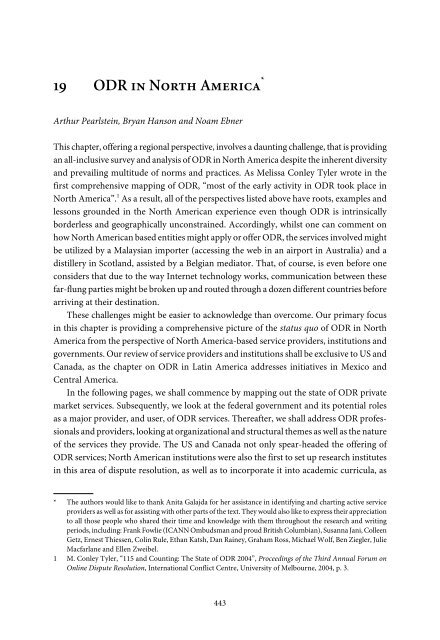
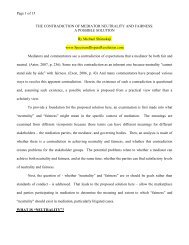

![Settlement Agreement Form [Agreement] - Mediate.com](https://img.yumpu.com/50682143/1/190x245/settlement-agreement-form-agreement-mediatecom.jpg?quality=85)
